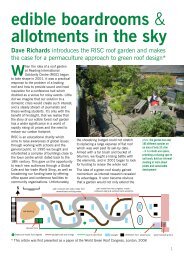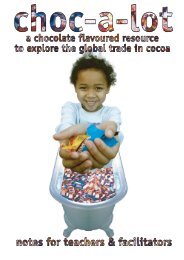Cost of coffee.indd - RISC
Cost of coffee.indd - RISC
Cost of coffee.indd - RISC
You also want an ePaper? Increase the reach of your titles
YUMPU automatically turns print PDFs into web optimized ePapers that Google loves.
aim<br />
fair marketing<br />
◆ To analyse the strategies, designs and images used in promoting and marketing Fair Trade<br />
products.<br />
outcome<br />
◆ A greater understanding <strong>of</strong> marketing strategies and the influence <strong>of</strong> media stereotypes.<br />
what you need<br />
Participants should be familiar with the principles <strong>of</strong> fair trade; examples <strong>of</strong> fair trade<br />
packaging and promotional materials (see Useful contacts, p77 and Weblinks, p78 for<br />
contact details <strong>of</strong> fair trade organisations); include Partners’ Blend, Nestlé’s Fairtrade c<strong>of</strong>fee,<br />
and download an advert, Bridging the generations, from www.risc.org.uk/readingroom/<br />
c<strong>of</strong>fee.html; Actionpages: Logo, Fair marketing and Press release; flip chart paper; glue.<br />
Ideally participants should be familiar with the analysis <strong>of</strong> images. If you need to see detailed<br />
examples <strong>of</strong> deconstructing text and images look at the activities Every picture… and Between<br />
the lines from the Seeing through the spin teaching pack. These can be downloaded from:<br />
www.babymilkaction.org/spin.<br />
what you do<br />
s Explain that fair trade organisations – producers, suppliers, shops, campaigners – produce<br />
produce a wide range <strong>of</strong> materials to sell their products and raise awareness <strong>of</strong> fair trade,<br />
ranging from posters and leaflets to the packaging itself.<br />
s Hand out Actionpage: Logo. Explain that these are either logos <strong>of</strong> organisations involved in<br />
fair trade or Fairtrade Marks which certify that a product conforms to fair trade criteria.<br />
s Taking each logo in turn, ask the group what words and messages the image communicates.<br />
Which are the most/least effective? Why?<br />
s Divide participants into small groups and hand out Actionpage: Fair marketing. Display<br />
selection <strong>of</strong> packaging and promotional materials. Ask groups to choose one and use the<br />
Actionpage to analyse its use <strong>of</strong> words and images.<br />
whole group discussion<br />
s Choose two or three groups to show their material and explain the main points <strong>of</strong> their<br />
analysis. Bring out more general points.<br />
◆ Which audiences are the materials aimed at?<br />
◆ What strategies have the PR or advertising agencies used to gain your interest, eg humour,<br />
guilt, striking image, human interest?<br />
◆ How well do text, images (photos, illustrations) and design (use <strong>of</strong> colour, layout, fonts)<br />
work together to communicate the message?<br />
◆ How do the materials give authority to their views?<br />
◆ How can you find out if the information provided is accurate?<br />
◆ Will material like this make a difference to your attitudes or the products you consume?<br />
Why/why not?<br />
◆ What would be the most effective way <strong>of</strong> reaching a group like you?<br />
key ideas<br />
◆ The fair trade movement grew out <strong>of</strong> Alternative Trading Organisations (ATOs) set up in the<br />
1970s. Through buying crafts and foodstuffs from trading partners committed to economic<br />
and social justice, they aimed to help poor people in developing countries improve their<br />
standard <strong>of</strong> living. Products were largely sold through their own shops, eg Oxfam, mail<br />
order, churches, solidarity groups etc.<br />
40




